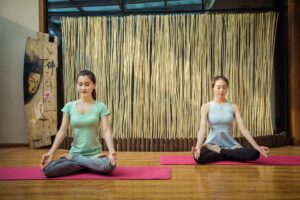How to Build Confidence as a New Yoga Instructor


Starting your journey as a yoga instructor can feel both exciting and intimidating. You may have completed your training, learned anatomy, mastered postures, and studied philosophy, but stepping in front of your first class brings a whole new challenge. Many new yoga teachers feel nervous about whether they are good enough or if students will trust them.
The truth is, confidence does not appear overnight. It grows with practice, preparation, and a willingness to embrace your unique teaching style. This article shares practical and proven strategies to help you build confidence as a new yoga instructor so that you can guide your students with clarity and ease.
Embrace Your Identity as a Yoga Instructor
One of the first steps to teaching yoga with confidence is embracing your identity as a yoga instructor. You may feel like you are still “just a student,” but remember that you completed your training for a reason. You have already invested the time and energy into learning. Trust that you have valuable knowledge to share.
Speak with authenticity and avoid copying other teachers. While it is helpful to observe mentors, your voice is what students connect to most. Your authenticity builds trust and makes your teaching relatable.
Practice Your Cueing and Instruction Skills
Clear communication is essential for building confidence in yoga classes. Many new instructors feel insecure about forgetting poses or mixing up directions. The solution lies in practicing your cueing until it feels natural.
You can do this by:
- Teaching friends or family for practice.
- Recording yourself guiding a sequence.
- Rehearsing cues out loud before class.
This preparation helps you deliver smooth and confident instructions, reducing nerves when you step in front of students.
Focus on Progress, Not Perfection
Every yoga class you teach will teach you something new. Confidence tips for yoga teachers often emphasize letting go of perfection. Students do not expect a flawless performance; they seek guidance, presence, and support.
If you forget a sequence or miss a cue, smile and move on. How you handle small mistakes shows more confidence than never making one at all. Progress comes from consistency, not perfection.
Develop a Strong Personal Practice
To build confidence as a new yoga instructor, maintain your own personal practice. Teaching and practicing yoga are different experiences, but both are important. A strong personal practice grounds you, sharpens your awareness, and reminds you why you fell in love with yoga.
Your personal practice also inspires your teaching. When you speak from experience, your instructions feel genuine and trustworthy. Students sense when a teacher embodies their own teachings.
Connect with Your Students Genuinely
Confidence grows when you focus less on yourself and more on your students. Instead of worrying about what they think of you, focus on how you can support them. Notice their alignment, offer gentle adjustments, and give encouraging words.
Building community in your classes also boosts your assurance. Greet students warmly, ask about their practice, and create a welcoming environment. A positive atmosphere helps you relax and enjoy teaching.
Use Sequencing to Build Self-Assurance
Planning your classes well in advance helps you feel prepared and calm. Create a sequence that matches your teaching level and the needs of your students. Overcomplicating a class can add pressure and reduce your confidence.
Start with simple, balanced flows, such as a gentle warm-up, a few standing postures, some seated work, and a final relaxation. Once you gain comfort, you can experiment with creative sequencing. Knowing you have a clear plan reduces anxiety and strengthens your presence.
Overcome Nerves as a Yoga Instructor
It is normal to feel nervous before a class, especially when you are new. The key is to manage nerves healthily. Some proven strategies include:
- Breathing deeply before class.
- Practicing grounding poses like Mountain Pose or Tree Pose.
- Arriving early to connect with the space and your students.
Remember, nerves show that you care. With time, the anxiety fades and is replaced with excitement.
Seek Support and Mentorship
Confidence tips for yoga teachers often include finding a mentor. A supportive community makes a big difference in your growth. Experienced instructors can share insights, feedback, and encouragement that help you refine your style.
Consider joining teacher networks, attending workshops, or taking advanced training. Surrounding yourself with fellow teachers helps you feel less isolated and more inspired.
Celebrate Small Wins
Confidence does not come in one big leap. It grows from celebrating small victories along the way. Maybe your students stayed engaged throughout class, or one person thanked you afterward. Acknowledge these moments.
Keeping a teaching journal can help track progress. Write down what went well and what you learned after each class. This reflection enables you to notice growth that might otherwise go unnoticed.
Continue Learning and Growing
Teaching yoga with confidence does not mean you stop learning. Stay curious and committed to growth. Attend classes from different teachers, study yoga philosophy, and explore new techniques.
Students respect teachers who remain students themselves. This humility builds both confidence and credibility. Growth keeps your teaching fresh and prevents self-doubt from creeping in.
Confidence is a Journey
Building confidence as a new yoga instructor is a journey, not a single step. It comes from preparation, practice, and a willingness to be authentic. Trust your training, focus on your students, and celebrate progress along the way.
Every class you teach is another opportunity to grow into the yoga teacher you are meant to be. With patience, persistence, and presence, your confidence will shine through.
